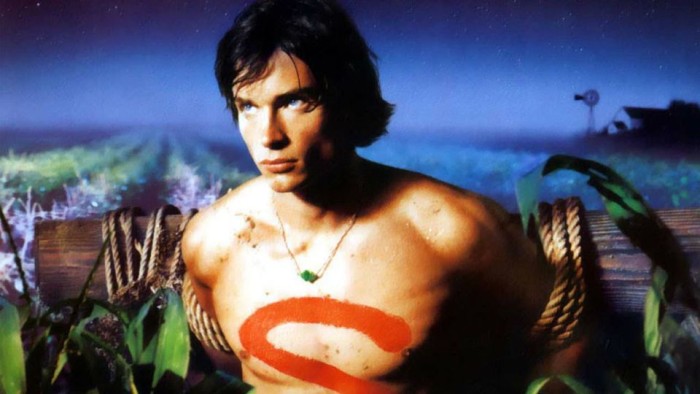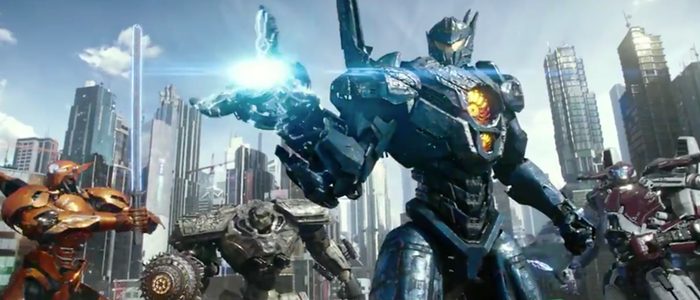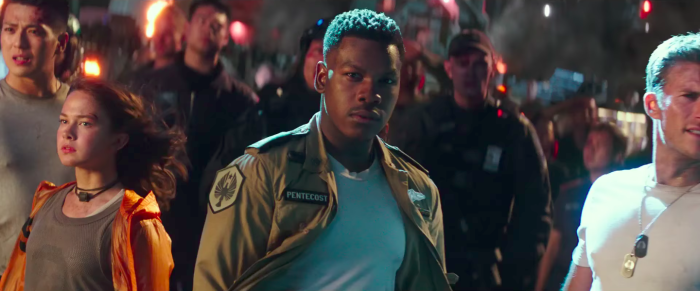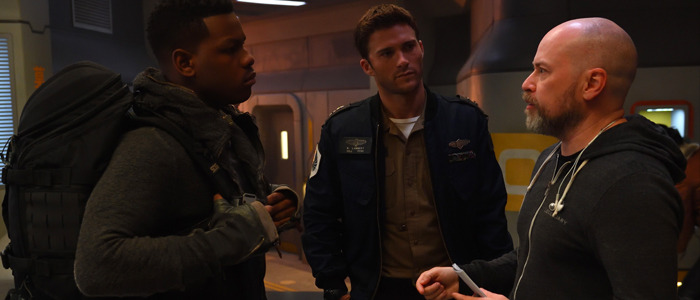Steven S. DeKnight On 'Pacific Rim Uprising', 'Smallville', Henry Cavill's Superman, And More [Interview]
Steven S. DeKnight has been a steady presence in television since the late '90s, working on shows like Buffy the Vampire Slayer, Angel, Smallville, Spartacus, and most recently, Marvel's Daredevil. And while he directed episodes of most of those shows over the years, Pacific Rim Uprising marks his feature directorial debut.
Earlier this month, I spoke with DeKnight in an air-conditioned trailer on the Universal Studios lot, where he talked about how the movie changed after Guillermo del Toro stepped out of the director's chair, how his background in TV inspired him to craft a writers' room approach to this script, the pop culture that influenced him (Johnny Sokko and His Flying Robot, anyone?), working with the cinematographer of Star Wars: The Force Awakens to bring this jaeger-sized sequel to life, and a whole lot more.
Steven S. DeKnight Interview
Guillermo del Toro has said he originally wrote a screenplay for this and worked on a few drafts before eventually stepping away to direct The Shape of Water. What sort of changes did you make to that script in order to put your own stamp on it?
We basically started from scratch. I put together a writers' room, very much in TV fashion. Half TV writers, half feature writers. I had a storyline in mind that I pitched to Guillermo that he liked, so I wrote an eight page outline, and from that outline, the other writers helped me flesh everything out. I picked two of those writers to actually co-write the script. We were on such a time crunch, all of us had to take a piece and start working on it.
What was that process like for you and your team? You just literally broke the script in sections and then combined the whole thing?
Yeah, basically what happened was, it was me and two other writers: Emily Carmichael and Kira Snyder. And we broke the script pretty much in half. Emily took one half, Kira took the other half, and as they would finish scenes, they would send them to me and I would rework them to put everything together. So it was a very fast, very TV-esque kind of process.
When you write and direct something yourself, you're able to write with a director's eye – knowing what's possible and practical to accomplish on set. But you worked with a few different writers on this. Were there any moments or scenes that any of your co-writers came up with that made the writer in you say, 'That's a great idea,' but the director in you say, 'How the heck are we going to accomplish that?'
All the time. Especially in the room when ideas were pitched, fantastic ideas, and I had to say, 'Look, I love that idea, but that's an extra $30 million that we are not going to be able to spend.' Or 'We are not going to be able to kill the main character 20 minutes into the movie.'
That was on the table?
Everything's on the table. What I love about the process of a writers' room is even as the director/co-writer, I throw out a lot of bad ideas. I throw out an idea, and everybody's like, 'Well, we don't like it because this.' And I'd be like, 'Yeah, actually, you're right.' So poking holes in the story is part of the process, and everybody pokes everybody. It's fantastic.
What was it about Kira and Emily that made you choose them for this project?
I had worked with Kira before. She was part of my writers' room when I was developing a sci-fi military show for Starz called 'Incursion.' So I knew her really well from that, and I always loved her writing. She actually wrote a script for that and I remember saying that it was the first time I'd ever read a script by somebody else that I wanted to direct that wasn't my own thing. And Emily I met through Legendary. I saw one of her short films that she did, which I thought was absolutely brilliant. It was quirky, it had great characters.
Which one was that?
It was the one about the two thieves. Really great. I don't remember the name of it. [Update: It's called Stryka, and you can watch it here.] But I was really impressed and I felt from a gut level that these two would be the right people. We wrote a whole draft with [Pacific Rim lead character] Raleigh Beckett as the lead of the movie, finished it. And literally the day after we finished it, Charlie [Hunnam, who played Beckett in the 2013 original] – who's wonderful – announced that he was doing his passion project: a remake of Papillon that shot right in the middle of our schedule. We couldn't move our shoot date because of the release date and another actor's schedule. So we had to quickly retool. [Producers] Mary Parent and Guillermo came up with the idea of the son of Stacker Pentecost, so we brought in writer T.S. Nowlin who had written The Maze Runner movies – fantastic guy – who really helped change it from Raleigh Beckett to Jake Pentecost.
A late, breaking development like that seems like something that would throw people into chaos. How did you all keep your heads in such a time of crisis when the release date is already locked in?
You just plow forward. One thing TV has taught me is that you'll get curveballs, and you've just got to say, 'OK, all right. This is not good, but how do we make it work?' It always happens. It's also great as a director because whenever you step on set, you come on to set ready to shoot Gone with the Wind. And then something happens, and suddenly you lose four hours and you have to throw everything you had planned out the window, so you just have to be nimble at all levels of making a movie.

You mentioned your time working in television, and I'd love it if you could tell me about your experience with Smallville. I was a big fan of that show when it was on.
Smallville was great. I was coming off of working on Buffy and Angel, and my friend Jeph Loeb, who went on to be the head of Marvel Television, was over there and said, 'Hey, come on over. We'll have fun.' I'd watched the show and I liked the show, so I said, 'Sure, why not?' Al Gough and Miles Millar, who ran the show, were just fantastic to me. I got a chance to write and direct and produce. It was great because I love Superman. I thought the take that Al and Miles had on doing Clark Kent before he became Superman as a teenager was fantastic. It was a lot of fun. It was grueling. I think that was the last time I did 22 episodes a year, and I don't think I could ever do it again. It's so much work. I've gotten spoiled by cable and streaming by doing eight to thirteen episodes a year. That seems a lot to me now.
What's the fondest memory you have from that series?
Oh, man. I was just tweeting back and forth with Lesley-Ann Brandt, who's on Lucifer. Apparently [Smallville star] Tom Welling is guest-starring, and she's like, 'Hey, I'm here with Tom!' One of my fondest memories is just working with the cast. Tom Welling was fantastic, Michael Rosenbaum just kept me in stitches non-stop. Every single member of the cast was so fun and so lovely. And I got to do a proto-Justice League episode, which was really a high point.
You have pretty extensive experience with Superman. What do you think about the Henry Cavill version of Superman in the DC movies?
I think he's fantastic, and I'm a huge Zack Snyder fan. Superman is one of the hardest characters, I think, because he's so powerful and so good. Batman, I think, is a lot easier to tackle, because he's a human guy that's messed up. Through his own wits, he goes out and fights the bad guys. Superman is a massively powerful alien from another world – much, much harder story. So you have Zack Snyder's take, which is a little grittier, and then you go back to Richard Donner, which was much more 'Gee whiz' kind of feel. Which I also love. But he is a hard, hard character, so I applaud anyone that tries to tackle Superman.

One of the things I liked about Uprising was the way it felt like a Looney Tunes cartoon at certain points. There's a moment when a jaeger welds a rocket to its arm, and the rocket whisks it around like Wile E. Coyote. Was Looney Tunes an influence for you? What kinds of things did you draw from for this?
(laughs) Actually, no. I drew on my influences growing up, which were very much Ultraman, Space Giants, Johnny Sokko and His Flying Robot. A lot of 'man in suit' Japanese monster movies: Godzilla, Rodan, Gamera. Those were really my inspirations, and also a touch of the movies I grew up loving in the '70s and '80s. Star Wars, Raiders of the Lost Ark – that kind of adventurous, fun kind of feeling, were really my biggest influences.
There are a handful of scenes in the movie where the characters are piloting jaegers and essentially getting their asses kicked. What did you do to dictate and differentiate the intensity of those scenes for your actors so it doesn't all become a blur?
Thankfully, unlike TV, we get to use pre-vis, which is the rough computer animation of what the scene will look like. Very, very early, usually before the visual effects company start the actual effects, we have this really rough pre-vis. So I'd always have my iPad with me, and when we were inside the com pod, before we would do any shot, I would say, 'OK, here's where we are, here's what happening,' so the actors were very aware. It's not like the old days where there'd be a green tennis ball and you'd say, 'Imagine a monster.' Now they get to see roughly what it's going to look like.
You've never worked with CG on this scale before. Was that a nerve-wracking process? I've heard stories about vendors turning in completed shots at the very last minute and the movie barely crossing the finish line in time. Was that your experience here?
There's always such a time crunch. Yes, there were definitely some minor shots that needed adjustment right up to the eleventh hour and even a little bit beyond that. (laughs) But it was really one of the best parts of the experience for me, working with Peter Chang and [effects vendor] Double Negative. I love visual effects. Every time I read somebody complaining online about, 'CGI's ruining the movies!' it drives me bananas. It's like, you don't understand how much CGI has helped push movies forward. Most people, when they think CGI, they think monsters, robots. They don't think the sheep in the background of Brokeback Mountain. They don't see the invisible CGI that allows you to create this stuff. The Marvel Cinematic Universe would not exist without CGI where it is. I'm a huge fan of that, and to get to work on this scale with giant jaegers and giant kaiju – and other simple things, like when Jake and Amara land at the Shatterdome and the ship's coming in. I love shit like that. That just excites me. One of my favorite processes was the review process for visual effects. Late in the post-production process, it becomes basically that's all you do every day. It's like five or six hours of sitting in a room with a laser pointer saying, 'This could be better. Can we do this? A little more atmosphere over here.' That, to me, was such a thrilling part of this.

What are some things in this movie that reflect the CG elements you're talking about – things that people might not immediately associate with CG? Were there any that you thought were integrated particularly well in the background or anything like that?
Oh, man. So many things. There's one shot that when we were reviewing it in the room, I forgot that none of it was real. It's when Jake comes out of the hatch in the jaeger in Sydney. The hatch was real. That was the only thing that was real about that. Just that hatch. None of the arm, nothing that he lands on – all of that was just boxes with green screen on it. I remember seeing it on the review and thinking, 'Wow, that set looks really good,' and then I remembered that's not even real!
You made headlines last year when you mentioned that there's been discussion about the chance of Pacific Rim crossing over with the King Kong and Godzilla movies. Have there been any more conversations about that idea?
Just in my own head. I don't want anyone to think that was an official Legendary thing. That was Steve DeKnight the fanboy talking about what he would love to see. I have an idea, a plan for the third part of this Pacific Rim trilogy that would open up the universe and allow that crossover if Legendary wants to. It's totally up to them. As a fanboy, I would love to see it. But if they want to keep it separate, I'll still be paying for my tickets to see Kong, Godzilla, and more Pacific Rim.
I know you're doing press all day today and you're probably hearing a ton of the same questions over and over again. I want to turn things over to you for a minute and ask: what aspect of the movie would you like to talk about that you haven't been asked about yet?
Obviously with a movie like this, a lot of the concentration is on the action, the CGI, the monsters, the jaegers. For me, what makes this movie really work are the characters and the interactions between the actors. I think for a movie like this to really succeed, you've gotta like the characters, you've gotta be drawn in by the characters, you've gotta hate the characters in the right way. Otherwise it's just noise and spectacle with nothing going on. One of the great things that Guillermo and [Pacific Rim writer] Travis Beacham did with this concept was putting two people inside a giant mech with the idea that you have to have two people working together. That soul in the machine is so important to this movie. Otherwise, that final battle in Tokyo would just be non-stop CGI. But instead, you have this human element that really grounds it and makes it more interesting, more emotional, and more fun.
Speaking of the human characters, you've got John Boyega leading this movie. He's so charismatic. He has that undefinable thing that whenever the camera is on him, he's just a movie star up there. Tell me about working with him.
Oh, man. My DP, Dan Mindel, and I, we would sit and review the movie in various formats for color correction, and every time John came on screen, we'd both look at each other and say, 'He's a movie star.' There's a definite difference between a great actor and a great actor who's a movie star. The first time I ever encountered that was I worked with Hugh Jackman briefly on a TV show. He walked into a room, and you're like, 'Oh, I understand. There is a genetic difference between the two species.' And John, man, he just has that movie star quality, and I'm really excited for people to see him in this movie. He's not the same as in Attack the Block, he's not the same as Finn in Star Wars. To me, he's a young Harrison Ford. He's roguish, he's handsome, he's funny, he's daring, he doesn't take himself too seriously. He can do the emotion. He just has it all. I think he's going to get bigger and bigger, and rightly so.
You mentioned Dan Mindel. He's the same guy who shot The Force Awakens with J.J. Abrams. What was your relationship like with him, coming up with the look of the movie?
Dan's a genius. He's one of the best cinematographers out there. When you're starting the prep for a movie like this, the studio sends you lists of possible costume designers, production designers, cinematographers, and I think the cinematographer was vital for this movie. I was going through fantastic names of people I'd love to work with, and then I saw Dan Mindel and I levitated off my chair. I thought, 'There's no way I'm ever going to be able to get him, but I'm putting his name at the top of my list.' He came in and we met. Dan's a fantastic guy, a very funny guy, but you need to get to know his personality. He came in, we talked, he left, and I told my associate producer Brook Worley, 'No way he's going to do this movie.' And she had worked with him before, and she said, 'No, I think he's going to.' Sure enough, the next day he signed on. And I think it made all the difference. We both really wanted to shoot this in 2.40 instead of 1.85, even though 1.85 lends itself to giant monsters and jaegers. I love the 2.40 format. To me, there's just something so cinematic about it. He also thought we should shoot with anamorphic lenses, which I also love. All of that combined, the movie is so rich and layered, and he's such a big part of that.
***
Pacific Rim Uprising arrives in theaters on March 23, 2018.

